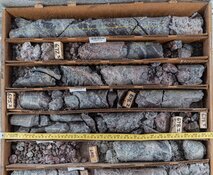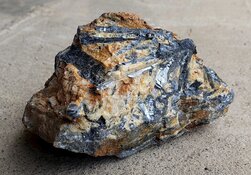My readers will notice that I often favor resource companies that have unconventional business models:
- Terraco Gold Corp. (TEN:TSX.V; TCEGF:OTCPK) (gold royalty)
- Medallion Resources Ltd. (MDL:TSX.V; MRD:FSE; MLLOF:OTCQX) (rare-earth processing from tailings (i.e., monazite sand))
- Great Lakes Graphite Inc. (GLK:TSX.V; GLKIF:OTCPK; 8GL:FSE) (graphite micronization and purification)
Meanwhile, most junior resource investors choose companies with more traditional "explore-develop-produce" models. There is little doubt that this model can work and that it can generate fortunes for early investors. However it is also a model that is high risk since it requires a lot of time and capital to develop.
There are cases where long-term investors made little to no money (or they lost money) despite the fact that the project in question is a success. A great example of this is Romarco Minerals. The Haile project is a high-quality multimillion-ounce deposit, but due to the amount of time and capital it took to prove this out Romarco Minerals had more than a billion shares outstanding. While most very early shareholders made money, it was not enough to justify the wait given the high risk of investing in junior resource companies. Most shareholders who bought during the last upcycle (2009–11) or subsequent to that lost money despite the derisking that was taking place, and despite the takeover by OceanaGold Corp. (OGC:TSX; OGC:ASX), a multi-mine regional producer (Southeast Asia/Oceania) with global aspirations. One can always point to company-specific issues, as well as cases in which companies have gotten into production quickly and without blowing out the share-structure (e.g., Tahoe Resources Inc. (TAHO:NYSE; THO:TSX)), however there is no denying the risks and difficulties of following this model.
The above-listed three companies, among several others, operate under the assumption that these risks merit a proactive rethinking of the explore-develop-produce model, with the goal of reducing the amount of time and/or capital it takes to get into business.
The explore-develop-produce model cannot be eliminated, but there are plenty of models that work within it or alongside it. Two are worth mentioning.
Narrow the Focus of the Business
The first is to narrow the scope of the business. The full extent of the value chain starts with rocks in the ground and ends with a marketable product. By working on adding value through just one piece of the value chain, companies reduce the complexity of their businesses and their capital costs. A great example of a success story here is Dynacor Gold Mines Inc. (DNG:TSX), which is a toll miller. It doesn't mine, rather it buys ore from local artisanal miners and processes it. The company has done very well, having generated profits in every year of the precious metals bear market and having grown its business. Dynacor has no debt, a tight share structure and rapid growth potential. We cannot simply attribute Dynacor's success to its model—after all, Inca One Gold Corp. (IO:TSX.V) is struggling with a similar approach—but we must attribute at least some of the company's success to the aforementioned benefits of focusing on a smaller-than-normal piece of the value-add chain.
There are two start-ups that I like that employ a somewhat similar model. More important, their management teams developed models geared toward mitigating timeline and capital risks. Great Lakes Graphite is buying graphite that it will process at its Matheson, Ontario, micronization facility. Micronized graphite is a saleable product or it can be further processed into material that is used in, among other things, lithium ion batteries. The company is selling graphite even while other non-producing companies got a 2+ year head start. The one thing these competitors have in common is that they are all looking to build mines and participate in a larger piece of the value-add chain: from ore in the ground to processed graphite ready for industry. The capex estimates for these projects are consistently above $25 million, usually above $100 million, and sometimes even above $250 million—quite a large fraction of the value of the entire graphite market.
Medallion Resources is looking to purchase monazite sand—a rare-earth phosphate mineral that is concentrated as a byproduct during heavy mineral sands mining operations. Heavy mineral sands are beach sands that are mined and processed for the production of titanium, zirconium and hafnium, among other things. This monazite material is treated as tailings, though it contains a much higher percentage of rare earths than any rare-earth mine or proposed mine. It has also been processed for its rare earths and thorium in the past, meaning the processes are known and the operating risk is mitigated.
Invest Passively In Projects
The second approach is to invest passively in projects. Usually this means holding a royalty or a stream, though it can also be a free carried interest in a project. Royalty and streaming companies come with several advantages, and the performance of the major players' stocks over the long-run speaks to this. But what makes the model—as opposed to the asset qualities—attractive from a derisking/simplification standpoint is the fact that streaming companies don't have to put up any capital once they've acquired the royalty/stream, except when it is specified and agreed to by the royalty/streaming company (usually to help finance a project expansion [e.g., Silver Wheaton Corp.'s (SLW:TSX; SLW:NYSE) Salobo stream]). Royalty and streaming companies benefit from all of the capital expenditures by its mining partners for as long as there is production or some other form of development. The mining companies do the development work and assume the risk of cost uncertainty, while the royalty/streaming partner has no capital costs and fixed, low/no operating costs.
Get In Early!
Companies that have been successful in developing non-conventional resource businesses have seen tremendous investor enthusiasm. We've discussed Dynacor and the major royalty companies, all of which have generated outsized long-term returns and appear on resource investors' radars.
But when such companies are early stage the market tends to overlook them. Investors in early-stage companies want something familiar, and for junior resource investors this means the explore-develop-produce model. If they are looking at an early-stage junior then what is familiar is generally a deposit or a geological anomaly that indicates that there is a heightened probability of finding a deposit. A toll processor such as Dynacor or a graphite processing and marketing company such as Great Lakes Graphite cannot show this to the market (both companies actually have exploration projects, though the development of these projects is peripheral to their respective business plans). In addition to the fact that these non-conventional companies actively work to mitigate certain risk factors, this heightened potential for investors to overlook such stories can create market disparities worth exploiting.
The Bottom Line
While resource investors are drawn to companies that work within a standard explore-develop-produce model, there are excellent opportunities in companies that don't utilize this model. Companies develop new models, for the most part, to combat the capital and timeline risks that come with the standard model. There are various approaches, of which we think two are worth your consideration. The first is to purchase material, rather than mine it, for further processing and marketing. The second is to invest passively in projects being developed via the conventional explore-develop-produce model, such as through a royalty, stream, or (rarer) via a free carried interest. These are certainly not risk-free approaches, but they do address the aforementioned capital and/or timeline risks, indicating that such businesses are inherently less risky, at least from a general standpoint. An added risk is that the advantages that are apparent to us are not readily recognized by or marketable to investors, but this is a double edged sword as it means there are hidden gems waiting to be found by those willing to step outside of the box and look for them.
Ben Kramer-Miller is the chief analyst at miningWEALTH. He is well respected for his unique ability to find under-the-radar precious metals opportunities, as well as for his extensive research into rare earth elements and other critical materials. His research has been featured by Nasdaq, Kitco, Mining.com, The Financial Post, The Globe and Mail, Investing News Network and RealClearDefense, among others.
Want to read more Gold Report interviews like this? Sign up for our free e-newsletter, and you'll learn when new articles have been published. To see recent interviews with industry analysts and commentators, visit our Streetwise Interviews page.
Disclosure:
1) Ben Kramer-Miller: I, or members of my immediate household or family, own shares of the following companies mentioned in this article: Silver Wheaton Corp., Great Lakes Graphite Inc. and Medallion Resources Ltd. I personally am, or members of my immediate household or family are, paid by the following companies mentioned in this article: None. My company has a financial relationship with the following companies mentioned in this article: None. I determined which companies would be included in this article based on my research and understanding of the sector.
2) The following companies mentioned in this article are sponsors of Streetwise Reports: Silver Wheaton Corp., Tahoe Resources Inc. and Terraco Gold Corp. The companies mentioned in this article were not involved in any aspect of the article preparation. Streetwise Reports does not accept stock in exchange for its services. The information provided above is for informational purposes only and is not a recommendation to buy or sell any security.
3) Statements and opinions expressed are the opinions of the author and not of Streetwise Reports or its officers. The author is wholly responsible for the validity of the statements. The author was not paid by Streetwise Reports for this article. Streetwise Reports was not paid by the author to publish or syndicate this article.
4) This article does not constitute investment advice. Each reader is encouraged to consult with his or her individual financial professional and any action a reader takes as a result of information presented here is his or her own responsibility. By opening this page, each reader accepts and agrees to Streetwise Reports' terms of use and full legal disclaimer. This article is not a solicitation for investment. Streetwise Reports does not render general or specific investment advice and the information on Streetwise Reports should not be considered a recommendation to buy or sell any security. Streetwise Reports does not endorse or recommend the business, products, services or securities of any company mentioned on Streetwise Reports.
5) From time to time, Streetwise Reports LLC and its directors, officers, employees or members of their families, as well as persons interviewed for articles and interviews on the site, may have a long or short position in securities mentioned. Directors, officers, employees or members of their families are prohibited from making purchases and/or sales of those securities in the open market or otherwise during the up-to-four-week interval from the time of the interview/article until after it publishes.





































